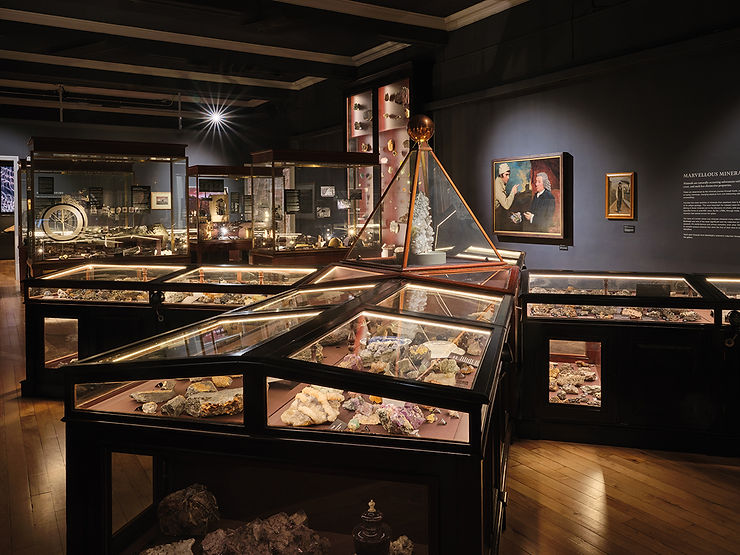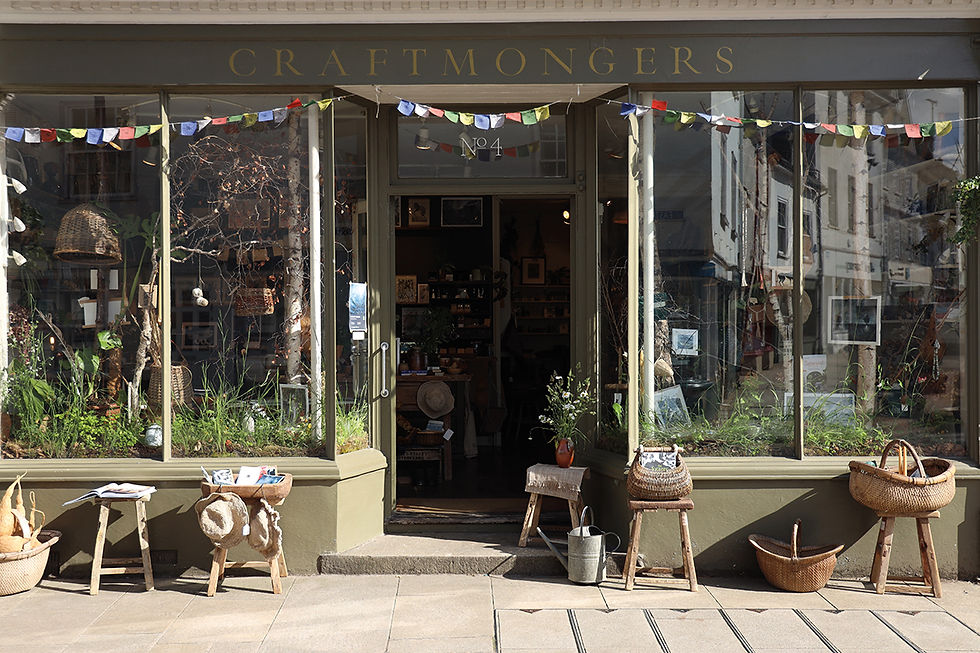Reimagining the museum
- Lucy Studley

- Apr 7
- 6 min read
Updated: Apr 29
Soaking up the past, present, and future at Cornwall’s new-look museum. Words By Lucy Studley
The concept of a ‘museum’ has changed more in the last 20 years than the previous 200. Gone is the notion of a fusty old institution, the preserve of academics and bespeckled hoarders. These days museums are home to cutting-edge technology, creative workshops, community groups and families seeking an enriching yet fun-filled day out.

For Cornwall Museum and Art Gallery, the modernisation process is an epic undertaking on the scale of an expedition by Truro-born explorer Richard Lander, whose medicine chest is one of its most prized artefacts. Previously known as Royal Cornwall Museum, the institution almost didn’t survive a funding and infrastructure crisis a few years ago. Now, thanks to a dynamic new Co-Directorship and grants from funds including Truro Town Deal and the UK Shared Prosperity Fund, the historic city centre landmark is firmly on course to become one of the country’s most unique and exciting regional museums.
The transformation began with the redesign of the museum’s Mineral Gallery. Home to a globally significant array of minerals, including 3,000 specimens donated by Philip Rashleigh in 1903, the collection is a kaleidoscope of the earth’s geological processes. Reopened to collective gasps last summer, the bold reimagining of this gallery set the tone for what was to come.

Entering the darkened space – adorned with a unique paint created by London Pigments and incorporating Cornish minerals – is like going underground. Here, spellbound visitors can discover the jewel-like colours and forms nurtured in the earth’s bedrock for millennia; azurites, cuprite, cassiterite, blister copper, quartz, and the world’s largest known crystal of liroconite. The display presents a rich seam of incredible specimens which have shaped the landscape and history of the region and the identity of its people.
And, if a bunch of rocks doesn’t seem that relevant to modern life, think again. From agriculture to construction, health to finance, minerals underpin our modern world. Today, Cornwall is emerging once again as an important player in mineral extraction with the Lithium industry, an essential component in phones and other electronic devices. Whenever you’re swiping, typing, watching or playing via a device, minerals – including Cornish ones – are at work. The ‘digital lab’ in the new space is an apt use of this interactive, immersive technology, bringing the story of the minerals bang up to date.
LEFT: Explore Cornwall's rich mining history ©John Hersey
RIGHT: A globally significant mineral collection ©John Hersey
For the museum’s Executive Director, Jonathan Morton, the transformation of the Mineral Gallery was something of a rite of passage. “People are rightly very attached to the museum and the collections we hold. The Royal Institution of Cornwall, the charity which founded the museum, is after all over 200 years old,” says Jonathan, who joined the museum in 2020 alongside Co-Director Bryony Robins. “Therefore, there was an understanding that we needed to modernise to bring in new audiences and secure the museum’s future, but also a responsibility to that long legacy. In the transformation of the Mineral Gallery, we were able to show that looking at things afresh can make them come alive again, helping people reconnect with the past and find new ways into big concepts, like how geology shapes our lives today.”

A similar thirst for fresh ways into big topics has shaped the design of the new Nature Gallery. This part of the museum reopened this spring as part of a major phase of the transformation which also included the introduction of a new Art Gallery, and the creation of the Heart of Cornwall Gallery. “In the new Nature Gallery, we set out to create a space which is both playful and thought-provoking,” explains Lauren Campbell, Engagement Manager within the museum’s dedicated and aspirational team. Working closely with specialist designers Wignall and Moore, and in collaboration with Cornwall Wildlife Trust, the ‘rewilded’ Nature Gallery celebrates Cornwall’s stunning landscapes, flora and fauna, and the historical conservationists, botanists, and citizen scientists who have helped us appreciate and understand them.
“This has always been a popular space with families, so we’ve incorporated sensory experiences, activities and play as ways into the overarching themes of sustainability and biodiversity” enthuses Lauren. However, the new space also confronts the challenges of climate change and habitat loss unflinchingly, but with hope for the future. As Lauren says, “we tell the success stories of conservation and recovery, showing how we can learn from the past as we strive for a brighter, more considerate future.”
Storytelling across space and time has also been central in reshaping the museum’s central gallery. Now known as the Heart of Cornwall Gallery, this is the ‘castle keep’ or seed bank of Cornish identity. Here, many of the museum’s iconic objects can be seen, from ancient standing stones to stunning 4,000-year-old gold lunulae, wrecker’s lamps to sections of the first transatlantic cable.
TOP LEFT: Mining brought great wealth to some ©John Hersey
TOP RIGHT: A blowpipe mineral analysis set made in Cornwall ©John Hersey
ABOVE: Studio Wignall and Moore led on the museum's redesign ©John Hersey
Collections Manager Jeni Woolcock explains the approach. “Here, we explore how the Cornish identity manifests itself through the arts, sciences, and industry, as well as less tangible facets of ‘Cornishness’ like the region’s rich storytelling traditions, profound relationship with the landscape, and rebellious spirit.”
The space may explore the unique identity of this small corner of the world, but the approach is far from insular. As Jeni puts it, “we uncover why visitors have long found a deep connection with a place where the land meets the sea, and why members of the Cornish diaspora all over the world still identify strongly with the land and culture of their ancestors.”
Meanwhile, the towering walls of the museum’s balcony have been put to the best possible use with a ‘salon hang’ of the institution’s impressive art collection. A floor-to-ceiling feast for the eyes, visitors are now able to soak up works from the German, Italian and Dutch renaissances, English history and landscape paintings, the Pre-Raphaelite and Newlyn schools, and St Ives modernism.
As Artistic Director, Bryony Robins, explains: “The art collection was begun over 200 years ago for philanthropic purposes. At the time, education was a privilege rather than a right and, with the prohibitive cost and time of travel, people who lived in Cornwall rarely got to see paintings and sculptures from the European canon of art history.”
TOP: The museum holds precious Cornish herbaria ©Adj Brown
ABOVE: The new Art Gallery
For example, Study of Three Girls’ Heads by Lucas Cranach the elder dates from c.1525 and is thought to be a triple portrait of Cranach’s three daughters. The collection also includes works by Constable, Hogarth, Terence Tenison Cuneo, Peter Lanyon, Bryan Pearce, Henry Scott Tuke, Stanhope Forbes, Christopher Wood and John Opie. There are also works thought to be from the studios or circles of Claude Lorrain, Willem van de Velde II, Giorgio Vasari, Jan Brueghel the elder, and Masaccio.
Alongside this impressive display of the permanent collection, this spring sees Kurt Jackson’s Biodiversity exhibition on display, in which the celebrated British landscape artist opens windows onto different locations across the UK and explores the spectrum of plant and animal life found there. From train tracks to ancient woodland, peat bogs to urban streams, ecological processes come under the scrutiny of his painterly eye.
Another exhibition, Withy Lore, explores the craft and heritage of withy pot making – traditional lobster pots which were used on the Cornish coast for centuries. St Petrocs Portraits is a group exhibition of portraits in tribute to the clients and staff of the Cornish homelessness charity, while Original Rebels by Camilla Dixon and collaborators explores the environmental activism of Barbara Hepworth and Patrick Heron.

“At the halfway point of the museum’s top-to-toe transformation, with a further phase to follow in a year or two, the museum itself is really beginning to reflect our whole outlook as an organisation,” enthuses Bryony. “Bold, creative, and ambitious, we’re using our collections to look back in order to make sense of our lives today and improve our future. I often imagine what the museum will be like in another 200 years – it’s an intriguing thought!”




















